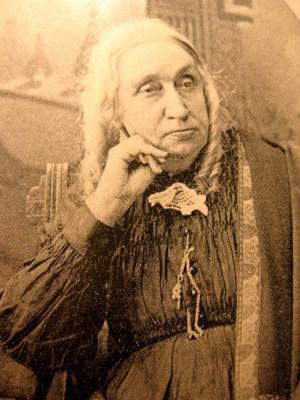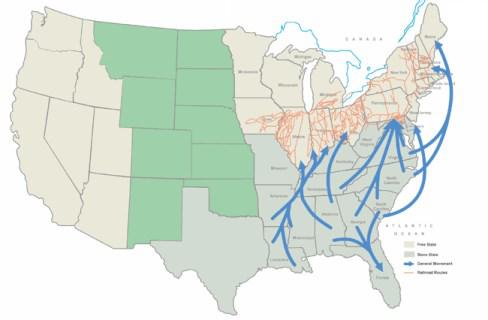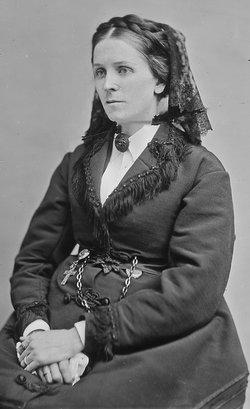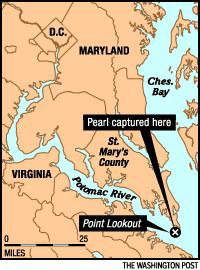Union Newspaperwomen in Confederate Virginia Image: Lida and Lizzie Dutton During the years preceding the Civil War, Quakers in Loudoun County, Virginia lived in a heated political situation. After their state seceded from the Union, they struggled to remain pacifists in the presence of Confederate troops. But three girl journalists in the town of Waterford had no problem asserting their support for the Union. Educating the Dutton Girls Like most Quakers, John and Emma Dutton of Loudoun County, Waterford, Virginia believed that girls should be as well educated as boys. The Duttons home schooled their daughters Emma Eliza (called Lida) and Elizabeth (known as Lizzie) at home, and encouraged them to exercise full use of their minds. Their cousin Sarah…

Clara Brown
Pioneer and Philanthropist in Early Colorado Traditionally, women’s philanthropic activities were tied to their husband’s wealth, but some women did it all by themselves. A freed slave, Clara Brown established a successful laundry business during the Colorado Gold Rush. She was a black pioneer, the first African American woman in Denver, a community leader and philanthropist. Image: Clara Brown between 1875 and 1880 Early Years Born a slave in Virginia in 1800, at a young age Clara Brown and her mother were sold to Ambrose Smith, a Virginian tobacco farmer. Smith was a kindly man and a devout Methodist; he took Clara and her mother to his church services.
Women of the U.S. Sanitary Commission
Patriots Who Volunteered to Aid Union Soldiers Image: Men and women volunteers in the backyard of the United States Sanitary Commission depot at Fredericksburg, Virginia The U.S. Sanitary Commission opened hospitals, organized supplies and educated government officials. Women volunteers raised money, collected donations, made uniforms, worked as nurses, cooked in army camps, and served on hospital ships and at Soldiers’ Homes. They organized Sanitary Fairs in numerous cities to support the Federal army and the work of the USSC. Backstory Abraham Lincoln’s victory in the presidential election of 1860 triggered South Carolina’s secession from the Union in December 1860; ten other states would follow their lead in the coming months. Women throughout America held their collective breath. Reverend Dr. Henry…

Lucy Colman
Educator, Writer and Freethinker Lucy Colman was an educator, writer and prolific social reformer who was actively involved in the abolitionist, women’s suffrage and Freethought movements. She also worked for racial justice and for the education of African Americans, accompanied Sojourner Truth on a visit to President Abraham Lincoln. Early Years Lucy Newhall Danforth was born July 26, 1817 in Sturbridge, Massachusetts, a descendant of John and Priscilla Alden [link] on her mother’s side. In her autobiography, she reported that from an early age, about six, she was horrified to learn of the existence of slavery, and bothered her mother with many questions about it. In 1824, Lucy’s mother died, and her mother’s sister Lois took over mothering tasks. Lois…
Sophronia Bucklin
Civil War Nurse from New York Image: Sophronia Bucklin Nurse at Camp Letterman General Hospital Gettysburg, Pennsylvania Born in New York State in 1828, Sophronia Bucklin was a seamstress before the war, but put aside her needle and thread to nurse wounded Union soldiers. In her memoirs, In Hospital and Camp: A Woman’s Record of Thrilling Incidents among the Wounded in the Late War (1869), Bucklin recorded her experiences. Eager to do her part for the war effort, Bucklin offered her services as a nurse: The same patriotism which took the young and brave from workshop and plow, from counting rooms, and college hall… lent also to our hearts its thrilling measure, and sent us out to do and dare…

Underground Railroad in Delaware
Delaware: A Short Path to Freedom Delaware, the northernmost slave state, may be small but it played a big part in the lives of men and women fleeing from slavery. The city of Wilmington was the last station on the Underground Railroad (UGRR). With the slave state of Maryland on one side and the free states of Pennsylvania and New Jersey on the other, Delaware offered a direct route to freedom. Image: Map of the United States showing routes traveled by fugitive slaves Running the Underground Railroad The system of aiding fugitives was established in the early 1800s, but the term Underground Railroad was not used to describe the network of secret routes and safe houses used by slaves to…
Civil War Nashville
First State Capital to Fall to the Union Army Image: View of Nashville from the steps of the Capitol Building, with Union artillery in place Nashville, Tennessee was an extremely important city during the Civil War. It was in the top 50 of the most populous cities with 17,000 residents. After Fort Donelson fell to Union troops February 16, 1862, Confederate authorities surrendered Nashville to Union forces without firing a shot. Union Occupation In February 1862, Confederate leadership surrendered two strategic Tennessee forts. A Union Army and Navy team under General Ulysses S. Grant took Fort Henry on the Tennessee River (February 6), and then captured Fort Donelson (February 16), only twelve miles from Nashville. After the fall of the…

Charlotte Denman Lozier
Doctor, Feminist and Social Reformer Charlotte Denman Lozier, physician, lecturer and professor at the New York Medical College for Women. A feminist, she campaigned for Women’s Suffrage and Workingwomen’s Associations as well as other progressive and charitable organizations. Image: Dr. Charlotte Denman Lozier Early Years Charlotte Denman was born March 15, 1844 to Selina and Jacob Denman in Milburn, New Jersey. Eventually a brother and sister were added to the family. Jacob had a strong desire to explore the frontier. When Charlotte was six, the family headed west. The 1850 Census reported them living in Napoleon, Michigan where her brother Robert was born. The family then moved on to Galena, Illinois. At the time of their next journey to the…
Widows of Gettysburg
Wives of Generals Killed at Gettysburg Image: Barksdale’s Charge by Don Troiani Confederate General William Barksdale – his hat off, his long white hair blowing in the wind – led his Mississippi brigade into battle to break the Union Line on the afternoon of July 2, 1863 at Gettysburg. This action would forever after be known as the grandest charge ever made by mortal man. Narcissa Saunders Barksdale and the General’s Dog William Barksdale, senator turned general, originally from Tennessee, moved to Mississippi as a young man, and settled near Columbus, where he studied law and was admitted to the bar. In 1849 Barksdale married Narcissa Saunders, who brought twenty slaves, horses, mules, and several wagon loads of household goods…

Pearl Incident
Mission to Rescue Slaves in Washington, DC Pearl was the name of a sixty-five foot Chesapeake Bay Schooner that was chartered by free African Americans for $100 to rescue 77 people from slavery in Washington, DC in 1848. The Pearl Incident was the largest recorded nonviolent escape attempt by slaves in United States history. Image: Map of the Voyage Backstory Like the nearby states of Maryland and Virginia, Washington, DC had a slave market and was part of the slave trade; because it was connected to the Chesapeake Bay by the Potomac River, slaves were shipped or marched overland through this city. Slaves worked as domestic servants and artisans for their owners, or were hired out to work for others….